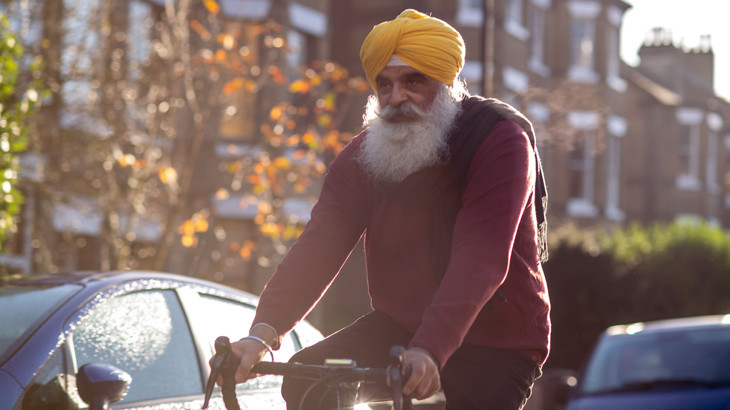Our Director of Impact and Insight, Andy Cope, explains how we're working with the Centre for Ageing Better to understand how people in mid-life (aged from 50 to 70 years) can be supported to take up active travel. And how they can maintain or increase their levels of active travel, as the first preference for everyday journeys.

Photo: Centre for Ageing Better
Active travel, including walking and cycling for transport such as to work, a shop or in meeting other local travel needs, is one of the easiest ways to build routine physical activity into daily life.
New research by Sustrans and CFE Research provides rich and varied insight into the views of participants aged 50–70 in the UK regarding active travel.
It's the first study of its kind, and the largest exploration to date of attitudes to active travel focused on people in mid-life.
Fifty people in the 50-70 years age group were interviewed.
We selected a wide range of people to ensure a mix of gender, age group, rural/urban locations, socioeconomic status and working status (including retired).
What the research shows us
The key insights from the research include the following:
1. People aged 50–70 do not all have the same capabilities, opportunities and motivations
So behaviour change interventions aimed at this group need to be targeted and granular.
2. While there are a range of health conditions that limit mobility, they do not all rule out active travel
So messaging on active travel in people aged 50–70 should not exclude people because of limited mobility.
3. The main differentiating characteristic in the 50–70-year age group is between those still working and those retired
So policies to encourage active travel in this age group should recognise the transitions and can address the need to prepare people still working for the changes in behaviour they may wish to make.
4. Race, age, gender and socio-economic status intersect to influence how people in this age group perceive active travel
Underscoring the importance of targeted and granular intervention.
5. Policymakers need to capitalise on the interest in walking for leisure amongst this age group to encourage extension to walking for purposeful travel
Which may require a better understanding of the dynamic between leisure walking and purposeful travel.
6. Changes in lifestyles and active travel habits brought about by lockdown provides policymakers with an opportunity to push at an open door
So policies should recognise this and may be designed to address ‘pandemic-enforced’ changes in habits.
7. Car-centric behaviours are usually formed much earlier than mid-life
So policies to target people at earlier stages are needed if long-term or lifelong active travel habits are to be formed.
8. Even though they're less intensive, cycling and walking bring major health benefits
Even though cycling and walking are less intensive forms of exercise than some of those in mid-life may have engaged with when they were younger, they nevertheless bring major health benefits.
So it may be possible to adapt messaging to appeal to groups transitioning from more intensive activity.
9. There is a lack of understanding of the contribution e-bikes and adapted bikes might make to a healthy lifestyle
Indicators suggest that the potential is huge, and we need to understand how to realise that potential.
10. Safe infrastructure is crucial in enabling more people in this age group to cycle
The provision of good quality, adequately segregated and maintained cycle paths is the single biggest enabler of cycling in people in this age group (especially women), as it is in other age groups.
So we need to improve the cycling (and walking) infrastructure.
Sustrans plans to build these findings into our delivery programmes to better support uptake of active travel among people in mid-life.





